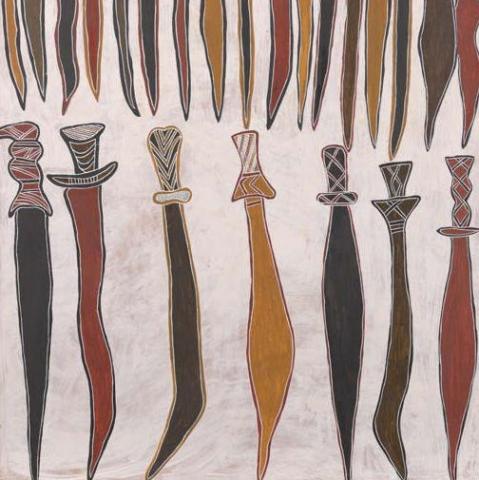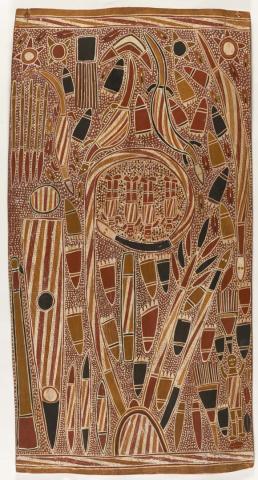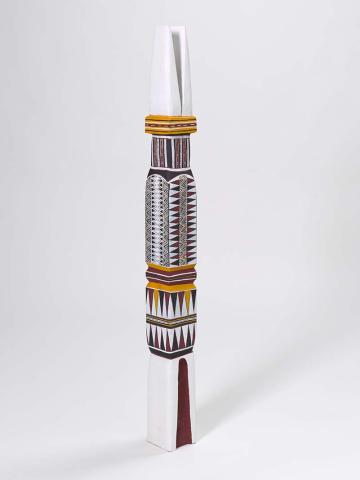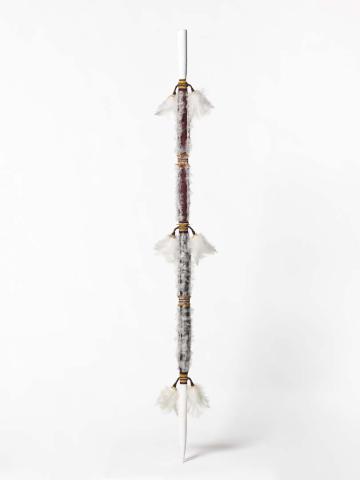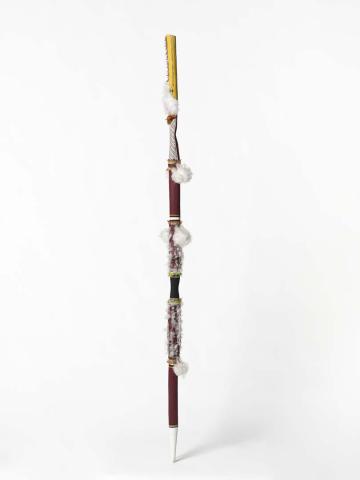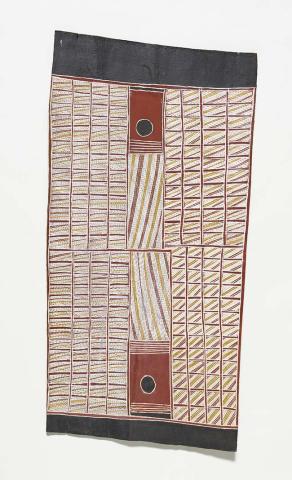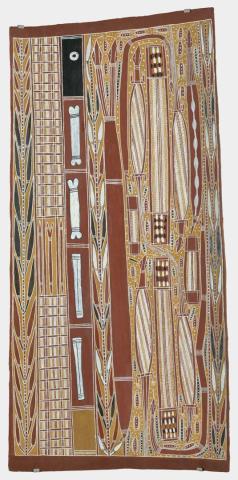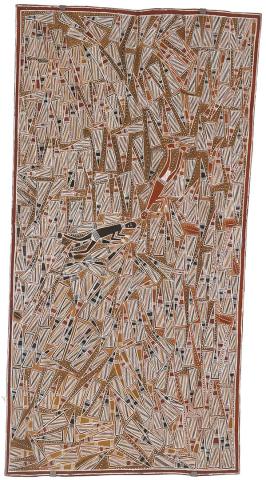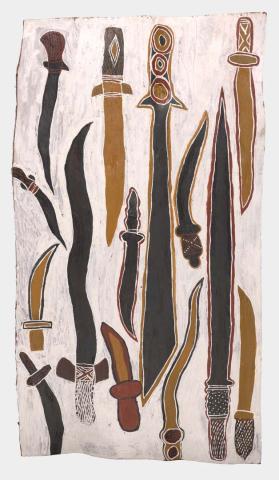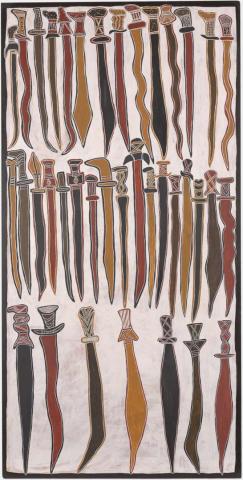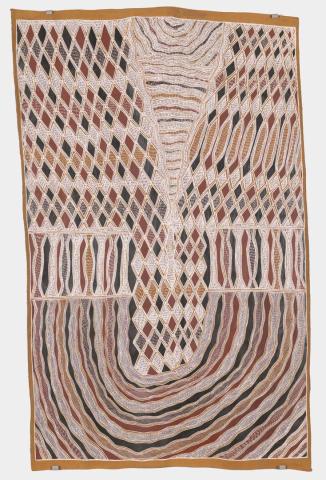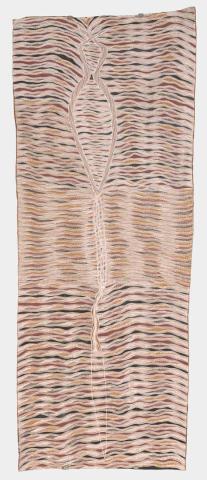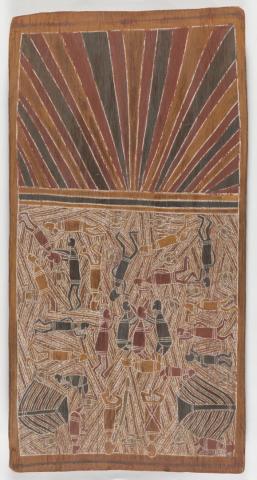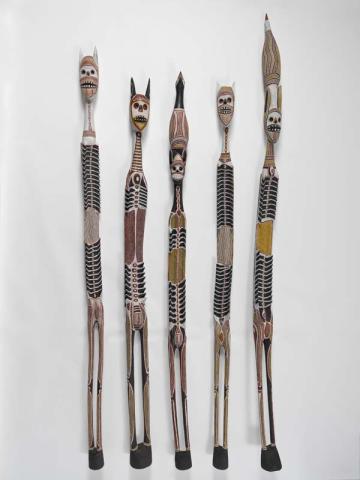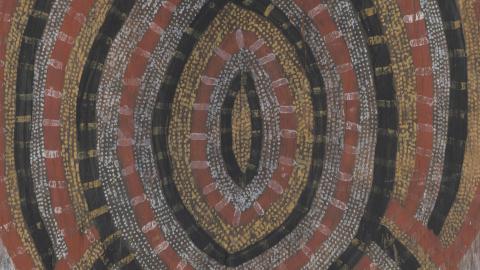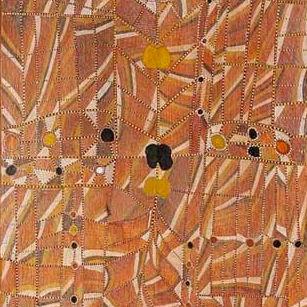Eastern Arnhem Land
Eastern Arnhem Land artists represented in ‘Transitions’ are from the islands off the coastline in the Arafura Sea — Yurrwi (Milingimbi) and Galiwin’ku (Elcho Island) — and from Ramingining Settlement on the mainland and Yirrkala to the far east. Rich in bush food, most of these lands are situated in savannah woodlands, jungles and swamps and are also connected with the abundant warm waters of the Arafura Sea.
Yolngu artists of the eastern Arnhem Land region know their country well and have long valued its beauty and their Ancestral links with the creation time; their paintings are rich with poetic detail of these monumental events, and the ceremonies and rituals around them. Some bark paintings also embody influential histories, from hundreds of years of interaction with Macassan fisher-traders from present-day Indonesia through to the establishment of the first Christian missions; the influence of World War II; the arrival of serious researchers (who published widely) and the interest of influential collectors, some of whom saw great potential for their art in Australian collections and internationally.
This vast area encompasses multiple language and clan groups. To ensure cultural maintenance on their lands, ceremonies connected with the major interconnected creation stories are conducted annually over the region.
With a deep knowledge and passion for truth and justice, artists of Yirrkala in the far east of Arnhem Land have an unbroken history of making important works to establish spiritual and political records of their rights to clan lands and sacred waters. An example in ‘Transitions’ is Yalangbara c.1960 by Mawalan 1 Marika and seven other artists. Mawalan was the revered leader of the Rirratjingu people of north-eastern Arnhem Land and father of a dynasty of talented artists, including Wandjuk Marika (1927–87) and Dhuwarrwarr Marika (b.1945).
From early 1950s and 1960s ‘traditional’ works on bark, Yolngu artists from the Yirrkala region have honed their craft to become perhaps the most successful community of artists to emerge from the bark painting tradition. With a passion inherited from their forbears they have committed to ever more creative artistic expressions, with works included now in major Australian art exhibitions and on the world stage.
North-eastern Arnhem Land: Yolngu/Macassan contact
Learn more about works by Larrtjanga Ganambarr, John Bulunbulun and Dhuwarrwarr Marika that document contact between the Yolngu people of north-eastern Arnhem Land and Macassan fisher-traders from South Sulawesi, Indonesia. For over 500 hundred years, Macassans travelled annually to the northern shores of Australia to gather the prized trepang (sea slug) — for a lucrative trade with China.
Works from Eastern Arnhem Land

Niwuda (wild honey) totem c.1963
- BINYINYUWUY - Creator

Untitled c.1965
- NGULMARMAR, Dick - Creator

Bakarra (Sacred stones) 2003
- BULUNBULUN, John - Creator

Body design - wind 2002
- BULUNBULUN, John - Creator

Hollow log ceremony 1965
- WULULU, Jimmy - Creator

Gurrmirringu - First man 1992
- MALANGI, David - Creator

Yulengor (Lightning snake) 2002
- BAKULANGAY, Wurrpandiya Marawili - Collaborating artist
- NAPUWARRI, Marawili - Collaborating artist

Dhalwangu gapu 1995
- WUNUNGMURRA, Nawurapu - Creator

Buyku 2019
- WUNUNGMURRA, Djirrirra - Creator

Buyku 2011
- WUNUNGMURRA, Djirrirra - Creator

Buyku (Larrakitj) 2019
- WUNUNGMURRA, Djirrirra - Creator

Mungurru VIII 2007
- MAYMURU, Galuma - Creator

Gan'yu (Stars) 2007
- YUNUPINGU, Gulumbu - Creator

Garak, The Universe 2004
- YUNUPINGU, Gulumbu - Creator

Larrakitj - Milngurr 2014
- MARIKA, Dhuwarrwarr - Creator

Milngurr 2007
- MARIKA, Dhuwarrwarr - Creator

Yalangbara 2019
- MARIKA, Dhuwarrwarr - Creator

Djan’kawu and his sisters 1980s
- MARIKA, Wandjuk - Collaborating artist
- MARIKA, Mawalan 2 - Collaborating artist
